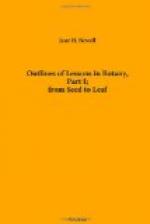Cut off the tapering end of a carrot and scoop out the inside of the larger half in the form of a vase, leaving about half of the flesh behind. Put strings through the upper rim, fill the carrot cup with water, and hang it up in a sunny window. Keep it constantly full of water. The leaf-buds below will put forth, and grow into leafy shoots, which, turning upwards, soon hide the vase in a green circle. This is because the dry, starchy food stored in the carrot becomes soft and soluble, and the supply of proper food and the warmth of the room make the leaf-buds able to grow. It is also a pretty illustration of the way in which stems always grow upward, even though there is enough light and air for them to grow straight downwards. Why this is so, we do not know.
3. Differences between the Stem and the Root.—Ask the pupils to tell what differences they have found.
Stems. Roots.
Ascend into the air. Descend into
the ground.
Grow by a succession of similar Grow only from
a point
parts, each part when young just
behind the tip.
elongating throughout.
Bear organs. Bear no organs.
There are certain exceptions to the statement that roots descend into the ground; such as aerial roots and parasitic roots. The aerial roots of the Ivy have been mentioned. Other examples of roots used for climbing are the Trumpet Creeper (Tecoma radicans), and the Poison Ivy (Rhus Toxicodendron). Parasitic roots take their food ready-made from the plants into which they strike. The roots of air-plants, such as certain orchids, draw their nourishment from the air.
The experiment of marking roots and stem has been already tried, but it should be repeated. Repetition of experiments is always desirable, as it fixes his conclusions in the pupil’s mind. The stem grows by a succession of similar parts, phytomera, each part, or phyton, consisting of node, internode, and leaf. Thus it follows that stems must bear leaves. The marked stems of seedlings show greater growth towards the top of the growing phyton. It is only young stems that elongate throughout. The older parts of a phyton grow little, and when the internode has attained a certain length, variable for different stems and different conditions, it does not elongate at all.




